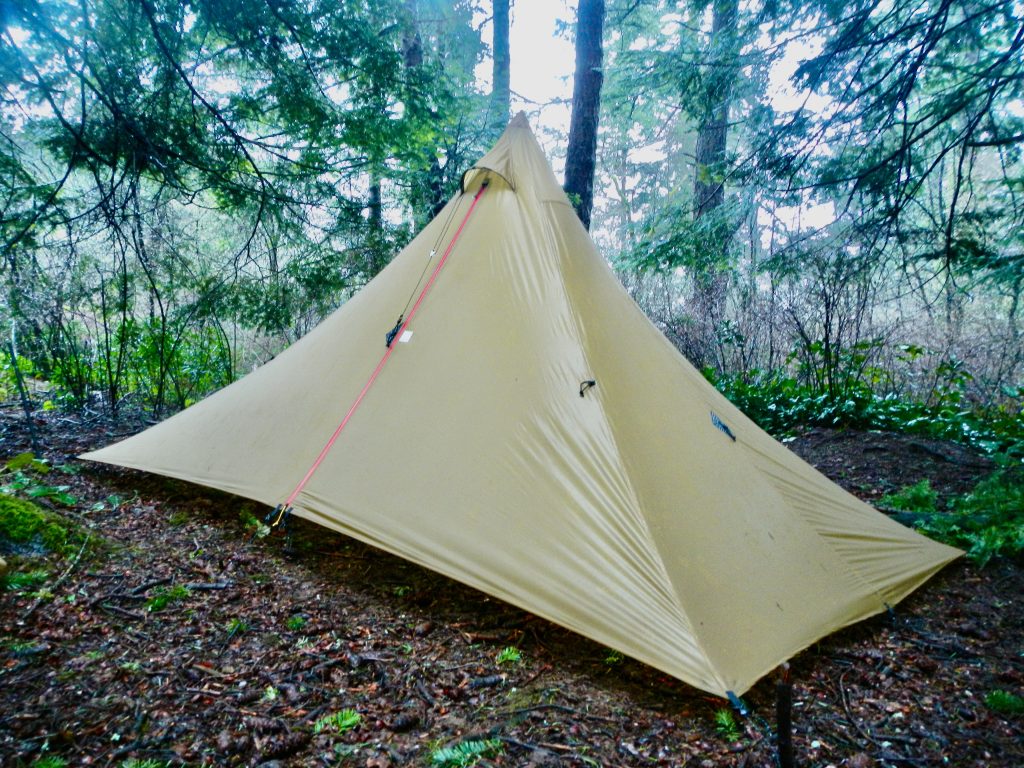 Summary
Summary
A generously sized pyramid is the ideal do-it-all shelter for a solo hiker. Locus Gear’s offering in this niche is the Khufu, which closely competes with offerings from Mountain Laurel Designs (Duomid), HMG (Ultamid 2) and Bear Paw Wilderness Designs (Luna 2). The Khufu stands out by offering class leading workmanship and the lowest weight (15.7oz in silnylon). On the downside, the small and mesh covered top vent is ineffective, the perimeter reinforcements are suboptimal and the lower weight is not achieved without a smaller gauge zipper and reduced height. Most hikers will be served well with the Khufu, but hikers frequenting harsh environments may prefer MLD’s Duomid.
Pros:
– Light (446g / 15.7oz in silnylon)
– Craftsmanship
– Velcro facilitates dual pole use
Cons:
– Ineffective vent
– Perimeter reinforcement material
– #3 main zip
Intro
I won’t digress into the full merits of pyramid shelters (hereafter “mids”) but they are the simplest geometry in the solo lightweight realm. Mids can be rapidly deployed with as few as 4 stakes, and it can be paired with an inner net tent, bivy or groundsheet to provide supplementary protection as desired. All competing designs fall short in either weight, simplicity or protection. For the solo hiker, a “two person” mid with a solo net tent or groundsheet positioned the back half is ideal as it provides a fully protected sleeping area as well as generous vestibule space in the front for cooking and gear stowage.
Locus Gear’s take on the 1-2 person mid concept is the Khufu, which they have been offering for several years in silnylon, cuben fiber or tyvek with a few revisions over that time. Information on the merits of these materials is widely available and won’t be discussed here other than suggesting cuben if cost is no object and winter use is unplanned, or silnylon as a more affordable and well rounded choice.
Fabric
The sil Khufu is constructed with a 30 denier silnylon rated at 3000mm hydrostatic head waterproofing. The fabric feels a bit different than the silnylon used by other makers (i.e. MLD, TarpTent). It’s more slippery (a crude indication of high waterproofness) but also perhaps a bit thinner/lighter. The base nylon may not be the commonly used 30D x 30D weave, but rather a 30D x 20D or something similar, which may be one of the ways Locus Gear has lowered the weight. In any case, it’s comically slippery but seems like a solid fabric choice.
Dimensions
The length and depth (265cm x 160cm or 104″ x 63″) are standard for this class of mid, while the height (130cm or 51″) is 3-6″ lower. The height isn’t directly a problem for a tall-ish hiker – I didn’t immediately notice coming from a DuoMid – but it does angle the walls inward more which drops the useable length slightly. At 5’11”, length is commonly a small issue for me in these mids. With a thick pad (NeoAir) and a winter bag I’m usually touching at least one of the ends. Sleeping at an angle, with the midpoints of the ends pulled out, or with the shelter pitched higher can mitigate length issues. Still, tall hikers should look elsewhere although few products offer more length (but see MLD’s SoloMid XL). The upside of the lower height is that this mid will pitch using most any adjustable trekking pole, while most competing mids require a pole jack or an unusually tall pole.
Door / Zipper
The Khufu door uses a two way #3 coil zipper which is Uretek coated (water resistant). This Uretek coating provides all the water resistance you need, so Locus Gear has wisely omitted a zipper flap which is a vestigial relic on some shelters from the days of cheaper untreated zippers (older Khufu’s had one). A #3 zipper will function fine for most, although small gauge zippers wear out more quickly than I prefer. Weight geeks will like the #3, but a #5 is ideal for long term durability and is provided by some competing vendors (i.e. MLD). Even better would be a toothed #5 zipper at slightly more weight. The zipper on the Khufu is also a two way zipper, which is handy for inserting the pole during setup since the top vent which normally allows for this is covered by mesh. Both sides of the doors secure easily via shockcord loops and a cordlock. The bottom of the zipper does not have a buckle, which MLD advocates for but virtually all other makers see no need for. For normal use this should be fine.
Vent
Similar to most mids, the Khufu uses a top vent to promote airflow and reduce condensation. The vent’s protective hood is excellently shaped with a stiffener that functions well and rebounds into shape after storage with no noticeable deformation like some others. The vent also secures to the door panel via a small cord with adjustable tension, presumably to avoid being lifted by high winds. This seems like an overkill feature that would require extraordinary winds, but perhaps this solution was easier than creating a closable vent as some mids have. Anyone finding this overkill can easily remove it.
The vent itself is an equilateral triangle of 5″ sides, which is small. It’s effectiveness is reduced by the inclusion of no-see-um bug netting which is of little value in a shelter that is open around the perimeter. I would like to see Locus Gear keep the hood but enlarge the vent by 1-2″ in length and omit the netting. I plan to snip my netting at some point.
Reinforcements
The Khufu uses two types of reinforcing fabrics: 210D Dyneema X nylon and PVC/Vinyl coated polyester scrim. The nylon is used for the 4 mid panel guyouts, while the PVC polyester is used around the bottom perimeter and internally at the apex. The Khufu uses 9 perimeter stake out points (one at each corner, one at each midpoint but two at the door). Each base guyout uses an excellent LineLoc3 tensioner.
The 210D nylon is a robust if not overkill choice for the mid panel guyouts and should function admirably in combination with the shockcord to buffer wind gust forces.
The PVC polyester scrim used around the perimeter is less suited to its task. Reinforcements should have similar stretch to the materials they reinforce so tension is shared between the materials. The PVC polyester has less stretch than silnylon, so tension at the perimeter stake out points is almost entirely loaded onto the PVC. This tension travels up the PVC and until it’s abruptly transferred back to the silnylon at the single line of stitching along the reinforcement’s edge. This abrupt transition combined with minimal stitching puts a great deal of stress on just a few contact points with the silnylon, which are prone to temporarily elongation (see below but enlarge). This situation could be improved by (1) using fabrics of similar stretch and (2) adding more stitching or using bonding so the tension is transferred to the silnylon in a more distributed manner. The Dyneema X reinforcements could use more stitching too.
A similar but opposite problem would exist for the cuben version of this shelter, as cuben with no stretch would bear the brunt of the tension while the PVC stretches. Six Moon Designs did something similar with their original cuben shelter – the Refuge X – and the cuben at reinforced areas was prone to tearing as the nylon they used shirked the load bearing responsibilities. For both cuben (CTF3) and silnylon versions of the Khufu this PVC material successfully reinforces the stitch holes where the grosgrain is bartacked to the silnylon, but it does little beyond this. This probably isn’t a major problem as some competing makers don’t reinforce silnylon at all where grosgrain is tacked on (i.e. Oware last time I checked), but it’s a missed opportunity to beef up the shelter. I added some stitching parallel to the direction of tension (shown below) to mitigate the differences in stretch and disperse the transition of force from the PVC to the silnylon over a larger number of stitches. This appears to work very well. Locus Gear should reinforce the silnylon with tougher nylon, and the cuben with tougher cuben (see HMG).
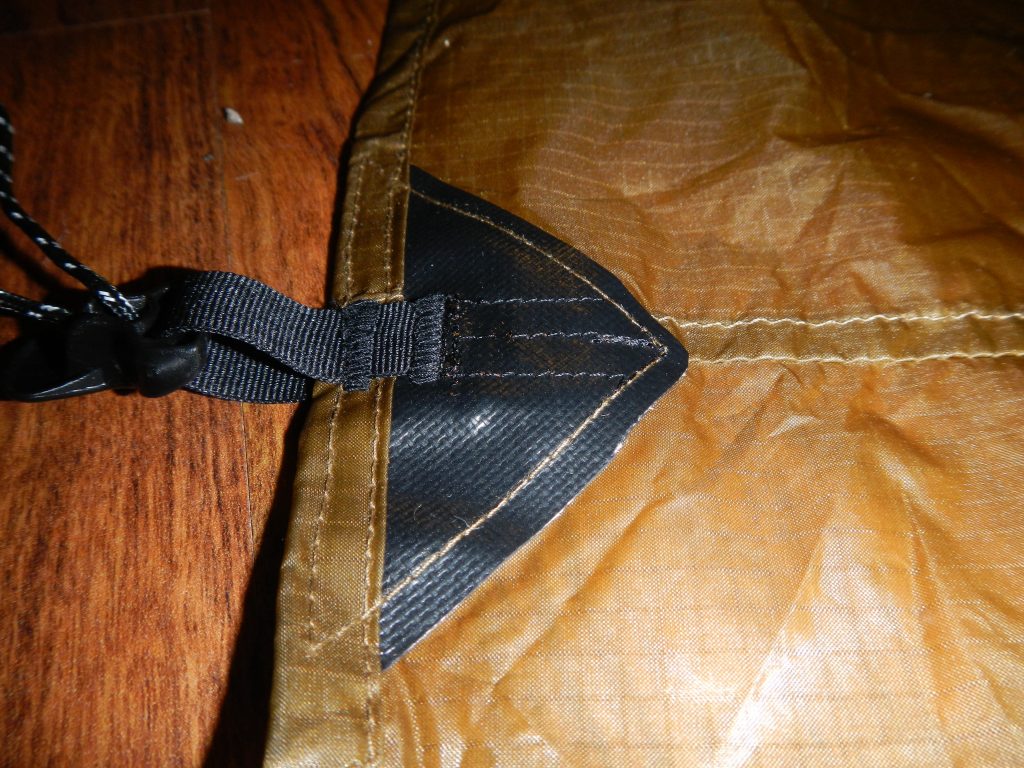
Other Features
PVC coated polyester scrim is also used to reinforce the internal side of the peak. This is a good use of this tough fabric. Still, don’t pitch the mid with your trekking pole tip up unless you’ve got the sharp tip protected with some sort of a cap. I use Locus Gear’s CP3 Joint to join the upper 2/3rds of both of my CP3 poles and achieve a pole with handles at both ends, but a regular CP3 pole could also be used.
Uniquely, Locus Gear has equipped the Khufu with velcro loops at on the inside of the side panels to connect the panels to your poles if you’re using their DTPE (dual trekking pole extender) accessory to use two poles in a V configuration. I don’t use the DTPE and can’t properly evaluate the merit of these, but they seem like a good idea to reduce panel flapping in the wind for an extra couple grams.
One feature that is missing is a loop at the apex to clip an inner tent to. Instead you have to connect the inner to the top of your pole, which means you can’t leave the inner clipped in place without it trying to escape as you roll up the shelter. I sewed a loop of webbing to the apex PVC in mine to solve this.
Buyers should know that Locus Gear lists a full size mesh inner tents for the Khufu on their site, but they also makes 3/4 and 2/3 sizes if you contact them. With a large (3/4 or full inner) you have a ton of protected space for one person, but very little space for cooking for storing wet gear. This is why I prefer a solo sized inner for a balance between fully protected and vestibule space, and less weight. Locus Gear doesn’t currently offer a solo inner but you can also use inner net tents from other manufacturers. They may be a bit tall since the Khufu is a a few inches lower than normal.
[UPDATE: The Khufu now includes an apex loop and a solo inner may be forthcoming]
Conclusions
The Khufu is a beautifully constructed pyramid that is the lightest option in this category and a solid choice for most hikers. Due to the light duty zipper and aforementioned reinforcement concerns, users who are expecting to push the limits of their shelter should look to MLD’s DuoMid which adds a larger gauge zipper, better reinforcement and a buckle at the bottom of the zipper for extreme conditions. With a few minor changes Locus Gear could substantially beef up the Khufu while retaining their weight and craftsmanship advantages. The Khufu would also benefit from a larger and netting free top vent and the addition of an apex hang loop. As it is, the Khufu remains an attractive choice for most users.
Disclaimer: I am not affiliated with Locus Gear or any manufacturer in any way, and received no discounts or assistance in purchasing this product.
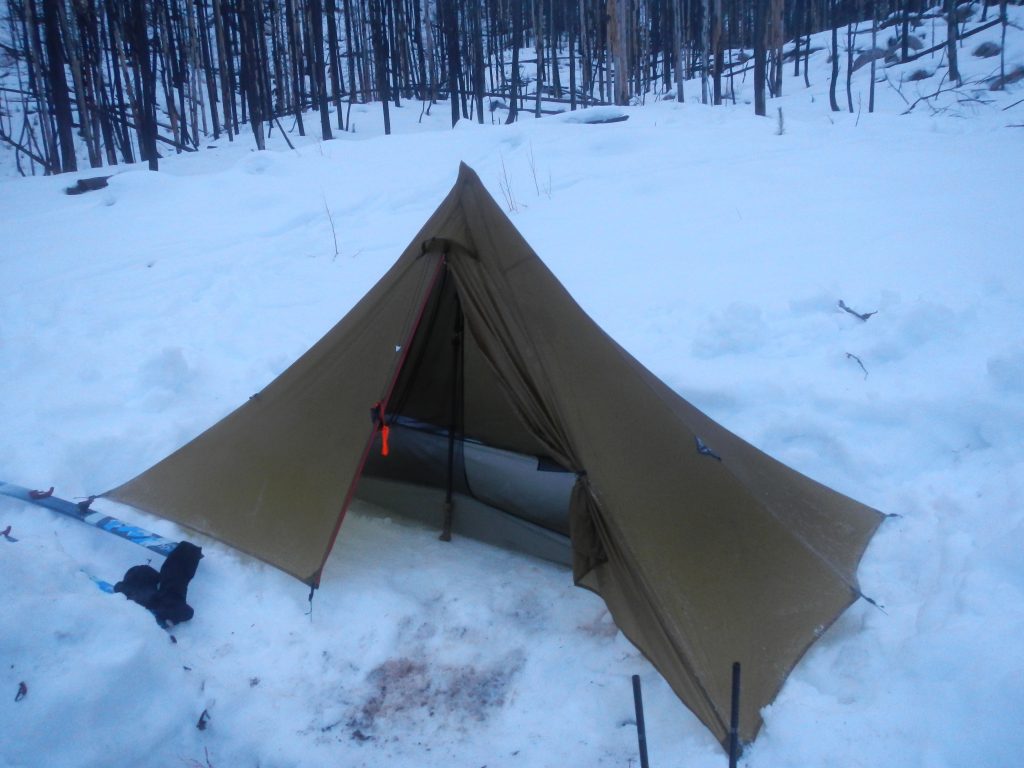
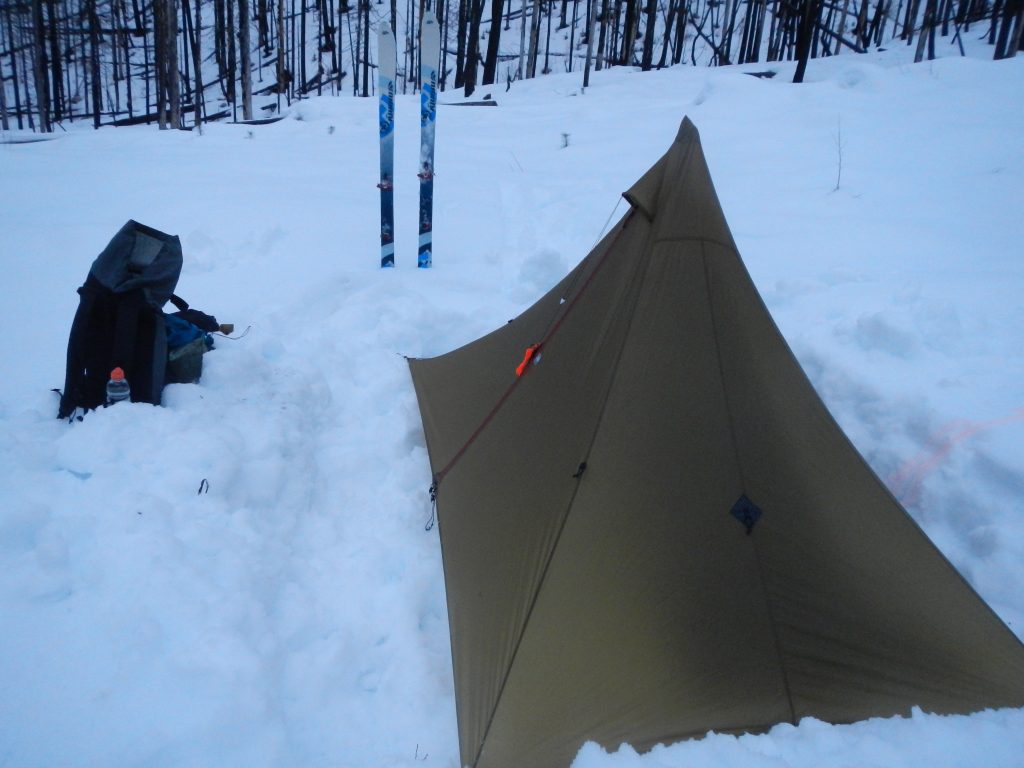

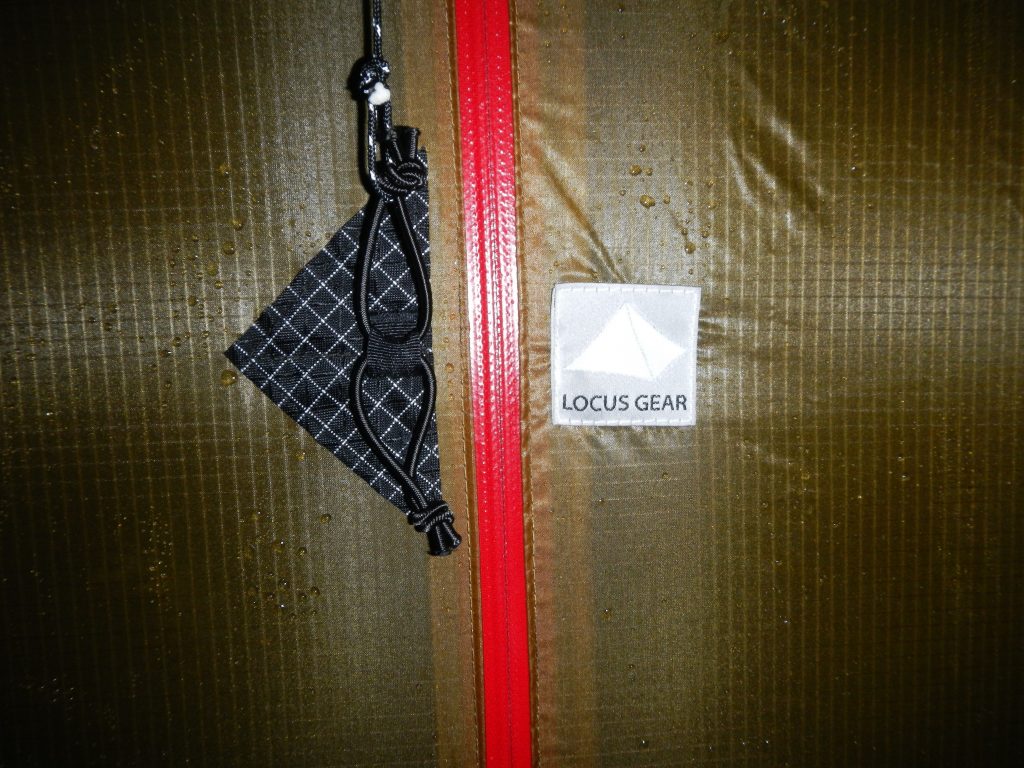
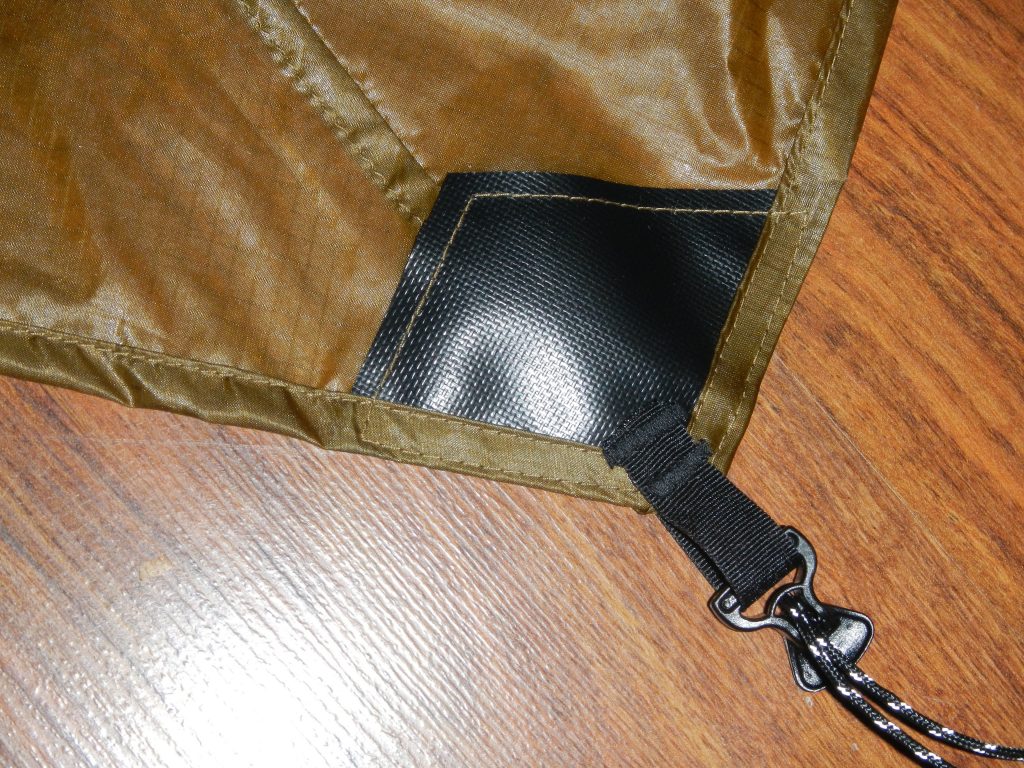
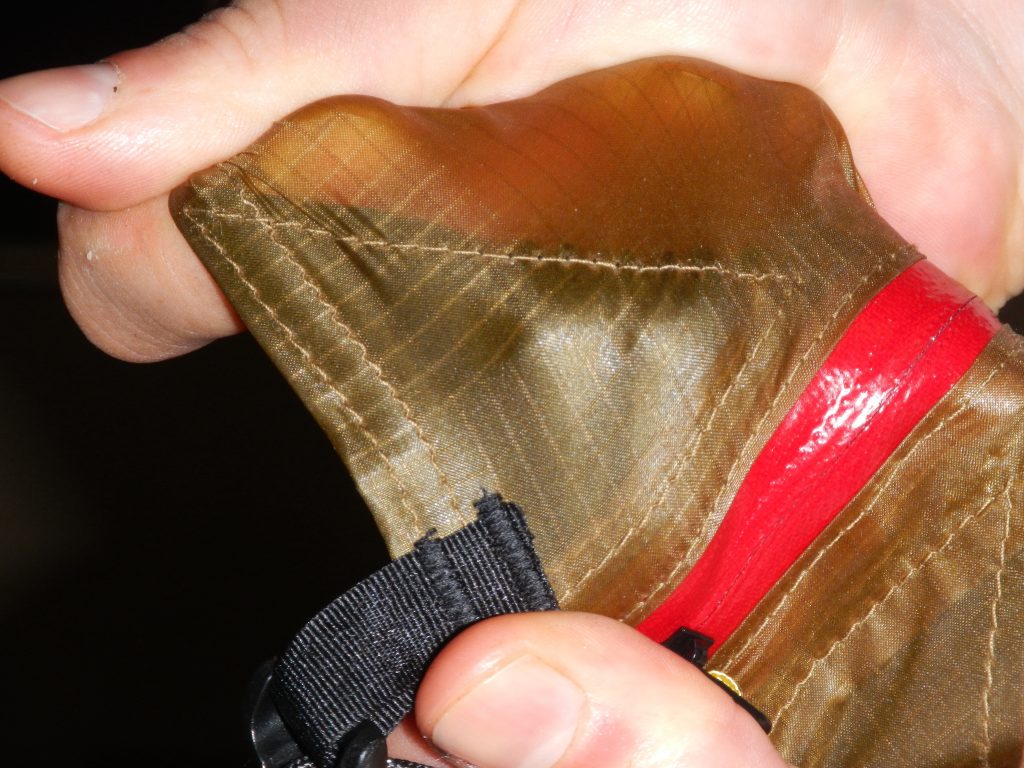
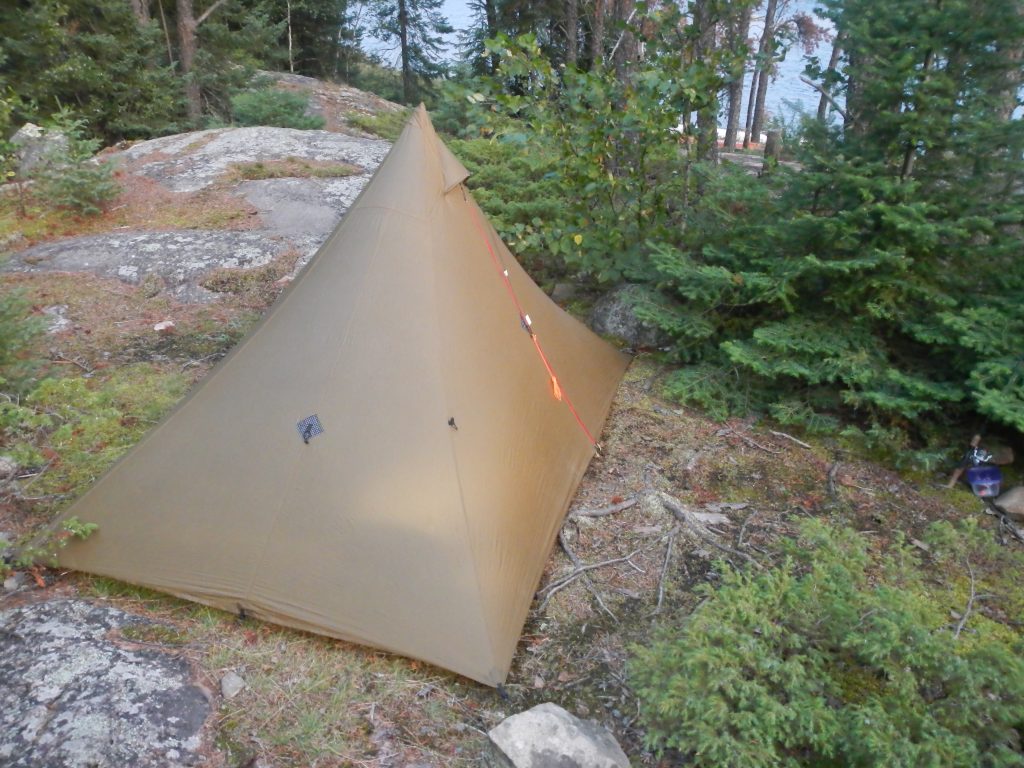
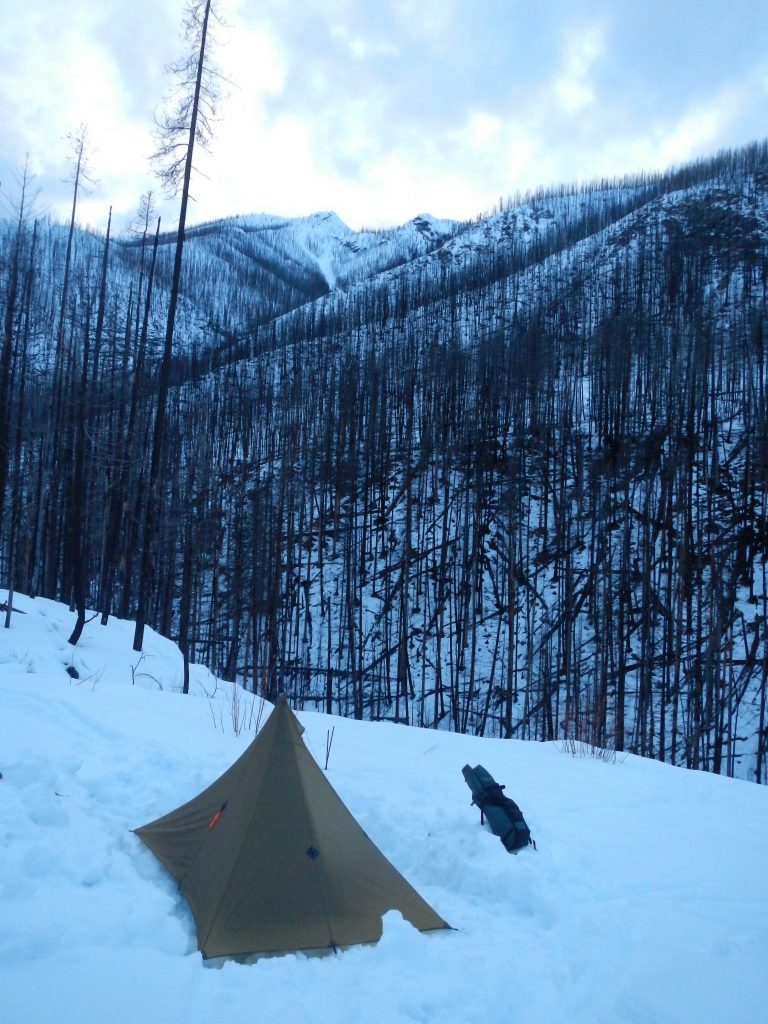
Thanks for the well thought out and balanced review. Nice job on the site.
Nice review Dan.
For solo use, the 2/3 inner makes a lot of sense, particularly when used with the DPTE, as you can pretty much sleep along the centerline of the tarp, under the highest headspace; you’re not pushed towards the back of the tarp, and you can stow gear along the back. At the same time, you have adequate space in the front 1/3 to cook and to stow cooking and wet gear, boots etc.
The bug net inner is preferable to the ripstop inner in terms of claustrophobia – with a bug net (mine is a third party 2/3 with cuben floor), there is minimal visual interference – I still feel I’m in an open tarp – but with the Locus ripstop 2/3 I also have, the experience is all interior, and rather confining. But if buyers are considering ripstop, I strongly recommend the extra vent, as otherwise it becomes rather stuffy. Locus Gear can sew on a hangloop to the tarp apex on request (well they did for me, and no charge).
Potential buyers should also be aware that the Locus 3/4 inner has a rather cunning asymmetry; the front of the inner runs from full depth at the left end to half depth at the right end. My personal preference is for symmetry, I find it psychologically better, and that is a consideration for extended trips, travel etc. A more centered space, with everything in its place. Secure against a potentially hostile world. But I can see the practical benefits of their 3/4 design.
Still uneasy about the lack of a storm flap over the zip, I must confess!
Thanks Robert. Good points.
Nice review. Far moire critical than I am capable of writing myself.
What kind of inner net tent is that in the 2nd photo?
It’s a homemade inner from someone on BPL. It was designed for a DuoMid. It works okay in the Khufu but it’s a bit tall so I have to drape it over the top of the pole to take up the extra height.
Thanks for this, really helpful. I’ve been deciding between LG and MLD for a mid to use in Scotland.
Why do you say to prefer silnylon over cuben fibre for winter use?
I don’t have any major reasons. Partly, cuben feels a bit suspicious when it gets really cold. Once it’s colder than 10C/15F, it seems stiffer and more crinkly. It feels brittle to me and I worry about how it would really do in a harsh, bitterly cold mid-winter storm. If nothing else, I suspect use in these conditions contributes to the eventual delamination of the material that occurs after it experiences a lot of stress.
Secondly, snow sticks to cuben a lot more than silnylon. You have to bang on cuben a lot more to get the snow to slide off (which circles back to the first point), and it’s hard to get it all off in some conditions (warm sticky snow). Cuben already packs quite a bit larger than silnylon and then after a snowfall it can be time consuming to clean it well enough that it packs to an acceptable size.
Thirdly, I’m just harder on my gear in the winter. I’m stomping around in boots and skis – often in a hurry. I’m pitching in harsher places etc. So I just like to use a cheaper material in case I accidentally stab my pole through the tent or slash it with a ski edge.
I like cuben, but I have a lot of smaller items that have seen a lot of use (sacks etc) and they look haggard far sooner than silnylon does. Tents are a different application with more torsion stress than abrasion, but I still don’t think cuben approaches silnylon in lifespan here. For example, I have used cuben drysacks for my sleeping quilt and these see very little abrasion – only torsion stress from rolling the drytop down – and the material peels and falls apart after 100-200 days. So overall I just can’t justify the premium for a material that won’t last as long and packs quite a bit larger. If I had more money and only camped 10-20 nights a year then I’d go cuben.
Thanks, these are great points. I have no experience yet with Cuben yet, but have been reading about it a fair amount. I am new to camping and researching things. I don’t mind spending money on quality items, and see the value in saving weight, but durability also factors in. I am going to ease into things but eventually I want to go camping in snow, I was thinking of buying either an eVent or DCF-B Khufu, but considering your points perhaps I should go silnylon. I have also been considering getting a hammock with a DCF winter tarp with doors like the Winter Palace. I have been reading more on tent design and it seems tunnel tents are more bomb proof than pyramids.
I still have lots to learn, I want to research a bit further rather than spend lots of money experimenting with different items but that’s probably half the fun. Thanks for the blog post and reply.